Decoding Generative Engine Optimisation (GEO): The Emerging Principles of AI Search
By Andrew Tomison:
AI Search Strategist & Researcher
AI is dismantling the foundations of traditional SEO. Tools like Google’s AI Mode and AI Overviews, ChatGPT, and Perplexity are changing how people get information. Your content may still be seen (an impression), but instead of clicking through to your website, users often get their answers directly inside these AI platforms. The result is a growing gap between visibility and traffic – a ‘great decoupling’ that forces brands to rethink how authority is earned.
Generative Engine Optimisation (GEO) has become shorthand for this shift. It is a broad, working framework for adapting to AI-mediated discovery — covering everything from semantic clarity and entity signals to new measures of influence such as citations and zero-click visibility.
Within this landscape, we introduce Dual-Intelligence Architecture (DIA) – our structured content system that puts GEO into practice. DIA is designed to secure upstream trust with AI systems first, then convert that authority into downstream visibility and human engagement.
A live seven-week case study validates the model. Without backlinks or paid promotion, DIA content achieved:
- Inclusion in Google AI Overviews for non-branded queries
- A Featured Snippet for our proprietary framework query
- #1 rankings for niche, high-intent terms
- Coverage across 40+ semantically diverse queries
- +213% impression growth for the core topic ‘generative ai seo’*
- A +3,167% surge in total page visibility*
Together these outcomes demonstrate how DIA can build machine authority, protect conceptual IP, and convert trust into branded search and agentic AI actions in a post-click landscape.
*A quick note on data: The impression figures in this study were recorded before Google’s September 2025 ‘&num=100‘ update. Please see the author’s note.
What You’ll Learn in This Paper
- Why the old SEO playbook is breaking – and how AI platforms like Google AI Mode, AI Overviews, ChatGPT, and Perplexity are reshaping discovery.
- The ‘great decoupling’: why impressions rise while clicks fall, and how to measure visibility in a zero-click environment.
- The scope of GEO as a broad industry framework – and the eight core strategic shifts it represents.
- How DIA fits within GEO as the structured content system designed for upstream machine trust and downstream human engagement.
- The five principles of DIA for building structured, machine-readable content that AI systems can parse and cite.
- Live results from a seven-week case study showing DIA in action.
- The new conversion paths in a post-click environment: branded search as delayed trust, and agentic AI as an emerging fulfilment channel.
- Practical steps to future-proof authority by aligning content with AI systems’ logic.
- Decoding Generative Engine Optimisation (GEO): The Emerging Principles of AI Search
- 1. The old SEO playbook is breaking. A new strategic logic is emerging.
- 2. The 'Great Decoupling': An Industry-Wide Shift
- 3. Generative Engine Optimisation (GEO): The Strategic Response to AI Search
- 4. Introducing Dual-Intelligence Architecture (DIA): Content Built for AI-Mediated Search
- 5. DIA in Practice: 7 Week Case Study & Proof of Concept
- DIA Outcomes in 7 Weeks
- Dual-Intelligence in Action: Building Authority from Zero
- Sign up for the latest actionable insights on AI Search.
- A Test of Authority – Without Backlinks or Promotion
- Visibility Without Ranking
- Third-party Recognition from Google
- From Core Terms to Conceptual Questions
- High-Intent Niches
- AI Overview Placement: Machine Authority for Human Engagement
- Securing the Brand Narrative & conceptual ownership for your intellectual property (IP)
- Branded Search and Agentic AI – New Conversion Pathways in AI Search
- Upstream Trust, Downstream Clarity
- 6. FAQs: Generative Engine Optimisation (GEO)
1. The old SEO playbook is breaking. A new strategic logic is emerging.
The rise of AI Overviews, ChatGPT, Perplexity, Google’s AI Mode, and forthcoming agentic systems are decisively changing the mechanics of digital discovery.
This isn’t just a technical upgrade. It’s a systemic shift in how authority and visibility are earned online.
AI-powered search is undermining traditional keyword targeting and click-based metrics.
But it rewards something more fundamental: demonstrable expertise that AI systems can parse, validate, and surface when users need trusted answers.
This new logic is already reshaping search behaviour — a phenomenon best understood as the ‘great decoupling’.
2. The ‘Great Decoupling’: An Industry-Wide Shift
What Is the Great Decoupling?
The ‘great decoupling’ refers to a growing disconnect between visibility and traffic – where impressions remain stable or increase, but clicks stagnate or decline. AI Overviews and generative results answer user queries directly on the results page, bypassing the need to visit external websites.
This isn’t marginal. Studies show AI Overviews can reduce click-through rates on the top organic result by 34.5%. Meanwhile, paid search CTR has fallen from 21.27% to 9.8%.
September 2025 Update: More recently, the intensity of this effect has been refined following Google’s removal of the &num=100 parameter, which triggered a visible drop in reported impressions across many sites. While part of the earlier impression growth was inflated by bot activity, the underlying shift remains: more users are getting answers directly from search interfaces like AI Overviews, without needing to click.
The Strategic Implications: A New Value System
This shift upends the core assumption of two decades of SEO: that a click equates to value. In the AI search era, that logic no longer holds. Citations and visibility within machine-generated answers are the new currency.
Authority is now earned by being surfaced, referenced, and trusted – even when no click occurs. To stay competitive, brands must prioritise zero-click visibility, entity presence, and AI-generated mentions.

Image from https://ahrefs.com/blog/the-great-decoupling/
Who Is Most Affected?
This transition impacts all sectors, but it hits hardest in high-trust, information-rich verticals such as finance, health, education, and B2B services.
That’s because 88% of AI Overview-triggering queries are informational. Brands built on expertise and credibility are most exposed.
But they are also best positioned to adapt – if they can restructure content for machine comprehension, semantic clarity, and citable authority.
3. Generative Engine Optimisation (GEO): The Strategic Response to AI Search
One emerging response is Generative Engine Optimisation (GEO) – a term originally introduced by Princeton researchers to describe how content structure and semantics affect visibility in large language models (LLM).
Since then, GEO has evolved into a broader and fast evolving industry shorthand for the strategic adjustments required to remain relevant in the AI search era.
While some debate whether a new label to replace SEO is needed at all, the scale of the shift has created space for new thinking – and GEO has become a useful working concept for those navigating the transition.
We take the view that GEO isn’t a finished discipline – but rather an important directional signal with eight core strategic shifts that define what businesses must now prioritise.
Shift 1. The End of the Click as the Imperative
Visibility (impressions) and traffic (clicks) are no longer tightly linked. High visibility can occur upstream, even without user interaction. The metric of influence has shifted into zero-click exposure, citation, and machine-level trust.
Shift 2. Success Is Measured by New Conversion Paths
Clicks aren’t the only outcome. Upstream authority now drives downstream branded searches, direct navigation, agent-initiated fulfilment, and other off-platform actions. These are harder to measure – but often more valuable.
Shift 3. The Role of a Website Is Evolving
Websites are no longer just destinations. They are becoming knowledge corpora: structured content libraries designed to be parsed and cited by LLMs upstream, while downstream they must remain clear and usable for human audiences.
Shift 4. Authority Is Built Through Niche Dominance
LLMs reward topical depth and semantic breadth. Authority is established upstream by delivering deeply authoritative answers to intent-rich queries – which then manifests downstream as recognised expertise and trust.
Shift 5. Citable Influence Is the New Top-of-Funnel
Being cited in an AI-generated answer is now a top-tier visibility outcome. It signals upstream authority that translates downstream into brand awareness – influence without interaction.
Shift 6. Entity Clarity and Structured Data Are Foundational
Machines don’t skim; they parse. Upstream clarity – built through content hierarchy, entity relationships, schema, and internal linking – is now the prerequisite for being understood and indexed in a machine-readable way.
Shift 7. Semantic Breadth and Intent Alignment Drive Fan-Out
AI systems test content against multiple query variations to assess its depth for conversational search. Pages with genuine semantic breadth and topical depth pass this ‘fan-out’ test and get surfaced repeatedly as trusted sources.
Shift 8. The Endgame: Trusted Agentic Fulfilment
As agents move from recommending to doing, the downstream goal is to be positioned as a fulfilment source. The content you publish upstream today shapes how AI tools act on your behalf tomorrow.
4. Introducing Dual-Intelligence Architecture (DIA): Content Built for AI-Mediated Search
The shifts outlined above point to a deeper change in how search now operates. AI systems have moved beyond indexing and ranking – they mediate meaning and even carry out actions for human users.
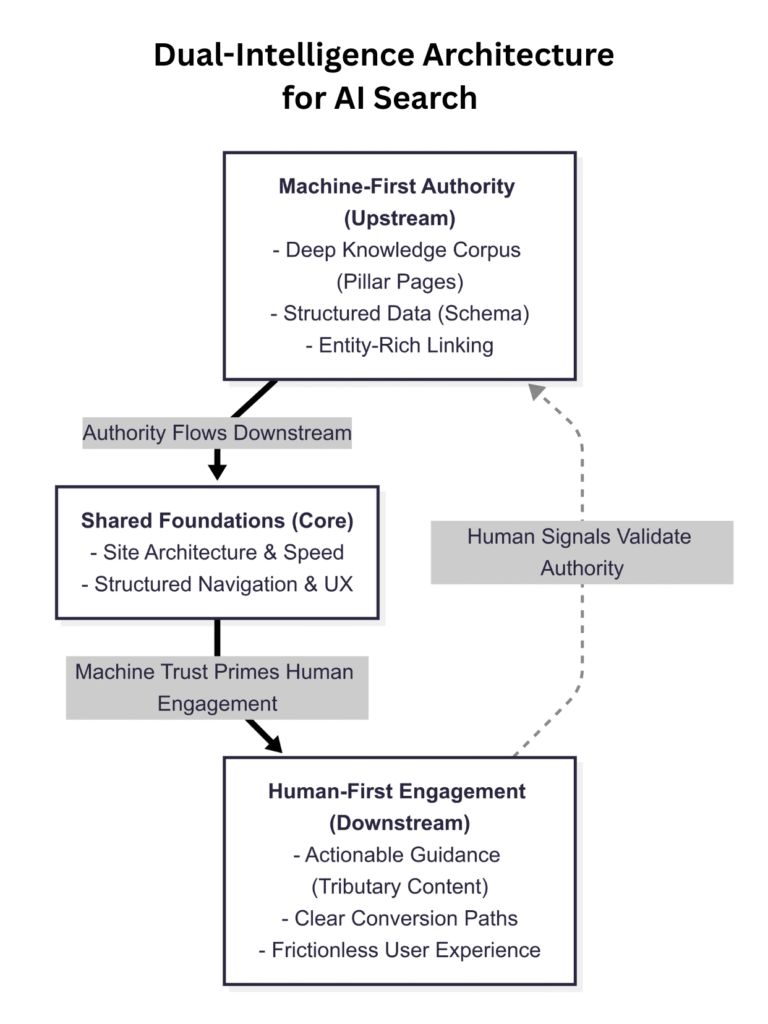
The shifts outlined above point to a new reality: content is no longer judged only by what happens on your website. Increasingly, it is reformatted and surfaced inside AI environments – ChatGPT, Google AI Overviews, Perplexity – where machines decide what is cited and trusted. The originality and structure of your ideas determine whether they carry through into those spaces.
At the same time, when users do arrive at your site, they expect clarity, relevance, and actionable guidance. A page that wins upstream machine authority but fails to deliver downstream human value will not convert trust into action.
Dual-Intelligence Architecture (DIA) is our model for meeting both demands. It works in two connected stages: first, establishing upstream authority by structuring content for semantic clarity, entity alignment, and depth; then, translating that trust into downstream engagement through clear navigation, user-focused design, and actionable insights.
In practice, DIA is about designing content ecosystems that speak fluently to AI systems and to people – ensuring your expertise is surfaced, cited, and ultimately acted upon.
5. DIA in Practice: 7 Week Case Study & Proof of Concept
DIA Outcomes in 7 Weeks
- AI Overviews inclusion for non-branded search
- Featured Snippet for branded query
- #1 rankings for niche, high-intent terms
- Coverage for 40+ semantically diverse queries
- +213% impression increase for the core topic ‘generative ai seo’*
- A +3,167% initial surge in page visibility growth*
*Please see the author’s note.
*Author’s note on Google’s ‘&num=100’ Update & impact on impressions
September 2025 Update – Google’s removal of the &num=100 parameter in Search Console triggered a visible drop in reported impressions across many sites, including this case study. Analysis across the SEO community suggests these ‘lost’ impressions were largely artificial – inflated by rank-tracker scraping and bot queries – rather than genuine user visibility.
As the data stabilises, we will assess and update the impressions trend and its impact on the case study and any flow-on impacts to the DIA method. In the meantime, the case study’s core evidence – citations, definitional snippets, #1 placements for niche terms, and branded query growth – remains intact.
Dual-Intelligence in Action: Building Authority from Zero
Our foundational pillar page, How Generative AI is Revolutionising Search (and Your SEO Strategy), was a real-world test of structured content through the DIA model.
It was built from scratch to see if we could establish a true knowledge corpus in a high-demand field where AI systems are still learning who to trust.
The strategic goal was to build a comprehensive, original resource that AI systems would cite and trust, establishing authority upstream with machines, then downstream with human users.
Principle 1: Original Human Insight
The content was built around original, human insight – not ideas already indexed by AI systems or widely recycled online.
It introduced new reasoning, precise framing, and evidence-based perspectives grounded in domain expertise. These signals align with Google’s E-E-A-T principles, demonstrating to AI true thought leadership rather than derivative repurposing.
Original content helps define, differentiate, and establish authority within AI-search systems.
Principle 2: Structured for Machine Parsing
The page was constructed with logic machines could parse at speed: linear flow, scannable sections, and clear semantic hierarchy.
Headings, sentence rhythm, statistics, evidence and chunked formatting were all deliberate. This builds on parsing principles discussed in the original Princeton ‘Generative Engine Optimization‘ paper, which explores how content structure influences large language model outputs.
The format ensures ideas are both clear within the page and contextualised in the broader semantic ecosystem, enabling generative AI systems to recognise their originality and topical nuance and to surface them in response to niche, intent-rich user queries.
Principle 3: Mapped to the Broader Semantic Environment
The page was positioned within a wider conceptual field – not built in isolation.
It was designed to sit adjacent to key entities, reinforce related topics, and expand broader topical coverage, positioning it as part of a larger semantic ecosystem.
This ensured the content was understood not just as an answer, but as part of the deeper knowledge graph shaping the topic itself.
Principle 4: Reinforced by Structured Data
Beneath the content layer, the page was reinforced with schema markup – structured signals that sit behind the text. These include elements like FAQs, article type, product details, authorship, and entity tags.
While AI can interpret narrative through natural language processing (NLP), structured data provides extra clarity by explicitly defining what the content is and how it fits together.
This reinforcement strengthens machine comprehension, helping AI systems classify content correctly and surface it with greater speed and confidence.
Principle 5: Built on Economic and Behavioural Logic
The page was architected with the logic of distribution in mind. Rather than chasing rankings or clicks, its structure aligned with the incentives of generative search – where authority, clarity, and semantic relevance now determine visibility in the post-click economy.
This reflects mechanism design principles: AI search functions as a two-stage market, first rewarding upstream authority and trust-building, then converting that credibility into downstream transactional outcomes.
This builds on research we’ve published on the psychology of AI search decision-making and mechanism design in the AI search era.
Sign up for the latest actionable insights on AI Search.
A Test of Authority – Without Backlinks or Promotion
This was a controlled implementation of the DIA model. The page was launched with no prior topical authority, backlinks, or paid promotion.
The objective was to test how far structured, original content – designed explicitly for AI systems – could go on its own merits. The question was whether content built on DIA principles could achieve AI citations, semantic coverage, and machine authority through structure and expertise alone.
It’s important to recognise this is an early case study. This isn’t volume proof — it’s structural validation of whether the DIA principles can generate AI recognition and authority signals.
Visibility Without Ranking
The Google Search Console chart below shows the first outcome of the DIA framework: immediate machine recognition, the precursor to human traffic.
From a zero baseline at launch on May 25th, the foundational How Generative AI is Revolutionising Search page gained traction quickly – earning nearly 2,000 impressions* in its first seven weeks without backlinks or promotion. For a new domain with no existing authority, that early visibility is a meaningful upstream signal: Google was already testing the content across a wide spread of queries.
Total Impressions: 1,930*
Average Position: 62.2
Total Clicks: 2
The key insight isn’t the clicks. It’s the upward trajectory of impressions — evidence that DIA’s structured, original content was parsed, trusted, and surfaced by the algorithm.
In this model, traditional rank is incidental. The real signal is AI visibility across semantic queries – establishing the upstream trust that later compounds into higher-value outcomes such as AI Overview citations, #1 placements, and branded search growth downstream.
*see the author’s note.
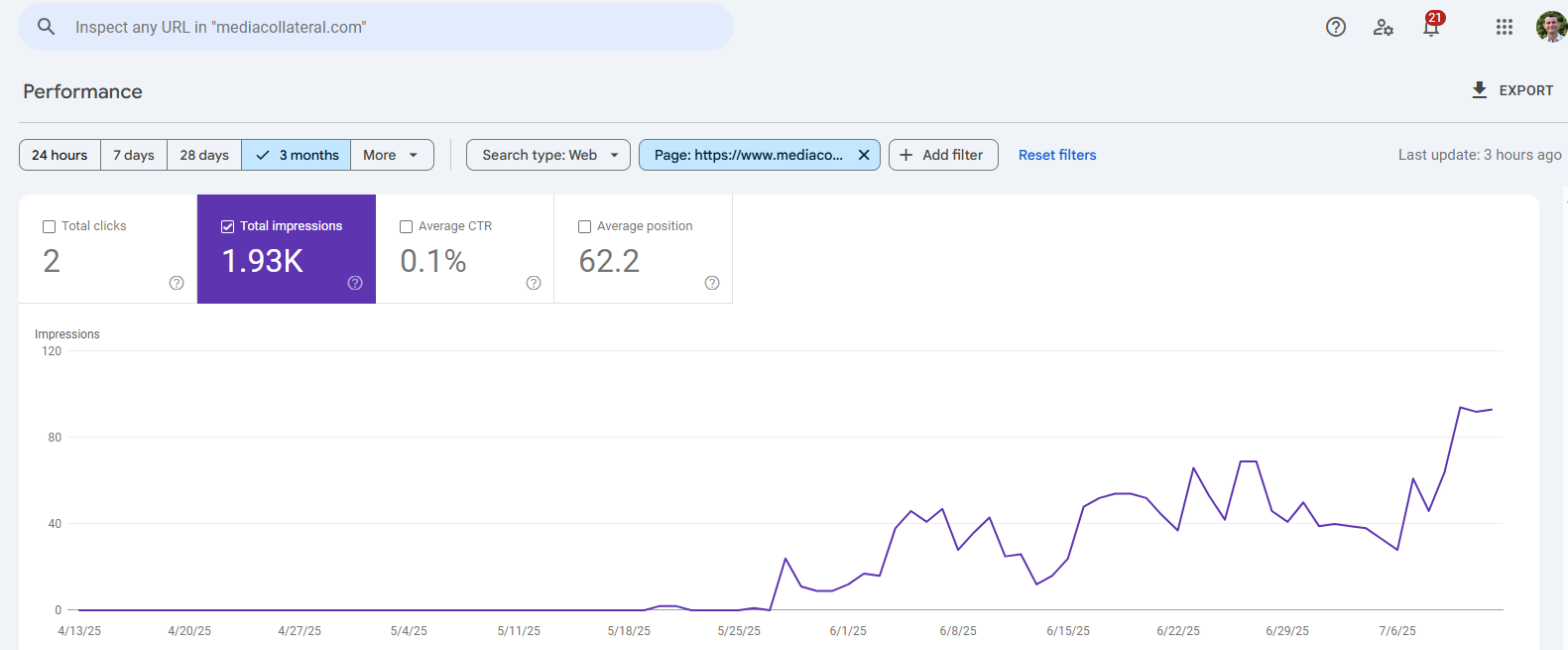
Data Insight
- Immediate Algorithmic Traction: Google surfaced the page within weeks of launch – without backlinks, promotion, or existing authority.
- Signal of Relevance: The upward curve in impressions shows AI systems were parsing and testing the content as a credible upstream resource.
- The Proving Ground: Even at an average position of 62.2, the page earned nearly 2,000 impressions* in seven weeks – an early signal of AI visibility across semantic queries that set the stage for later AI Overview and ranking wins.
Third-party Recognition from Google
Beyond internal charts, Google itself flagged the page’s early performance. Automated milestone alerts in Search Console were triggered at two levels, signalling that the content was starting to register as relevant within the system’s semantic layer:
- Page-Level Recognition: A +3,167% impression growth* alert marked a sharp rise in visibility. While this shift began from a zero baseline, the fact that Google flagged it indicates the page’s structure and relevance were being actively recognised.
- Core Topic Validation: A second alert showed a +213% increase* for the query “generative ai seo”, demonstrating early topical alignment and entity-level trust.
Together, these alerts show that Google’s systems were surfacing and testing the content both broadly and topically – early signs that the DIA framework is resonating with how AI search layers parse and validate structured content.
*See the author’s note.
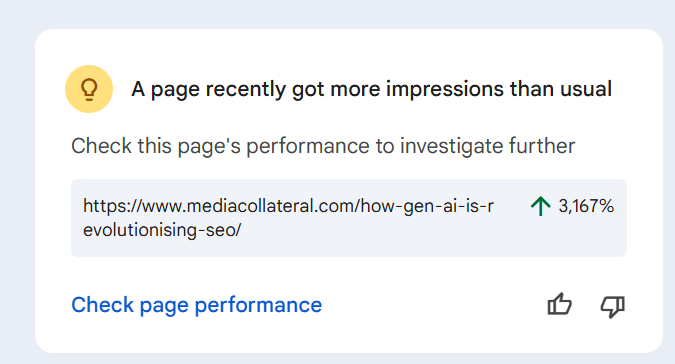
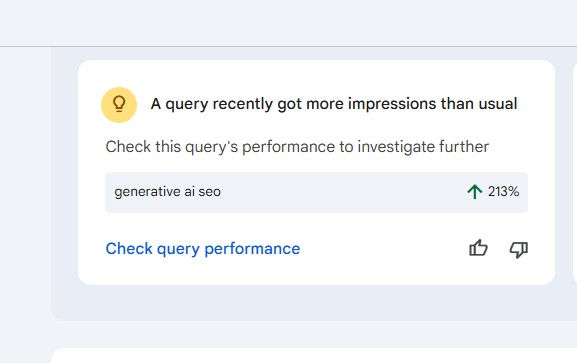
Data Insight
- Emerging Signal: Alerts are only triggered when Google detects a material shift in visibility. Their appearance confirms the page was starting to gain algorithmic recognition.
- From Baseline to Recognition: The percentage increases began from a standing start, but their significance lies in Google choosing to surface and validate the page despite no backlinks, brand weight, or paid promotion.
- Strategic Indicator: While not an end-point, these alerts are early proof that the content aligns structurally with how Google identifies and elevates authority – a validation of the DIA model’s design.
From Core Terms to Conceptual Questions
The strength of a true knowledge corpus lies not in ranking for a single keyword, but in its ability to surface across a wide range of queries — particularly those where AI systems are seeking semantically rich, trustworthy sources.
In just over one month, the foundational pillar page was surfaced for over 40 distinct queries within the target topic, indicating a level of semantic breadth that extends well beyond narrow keyword targeting. These queries span a spectrum of user intent, including:
- Core Strategic Topics like ‘generative ai seo’
- Hyper-Specific ‘How-To’ Questions such as how to set up alerts for brand mentions.
- Abstract and Conceptual Explorations like ‘evolution of seo with generative ai‘
This diversity indicates the page is not merely optimised; it has been successfully architected as a comprehensive resource.
By earning trust across this wide array of queries, it establishes the broad topical relevance necessary to then win the #1 position for high-intent niches, which we will examine next.
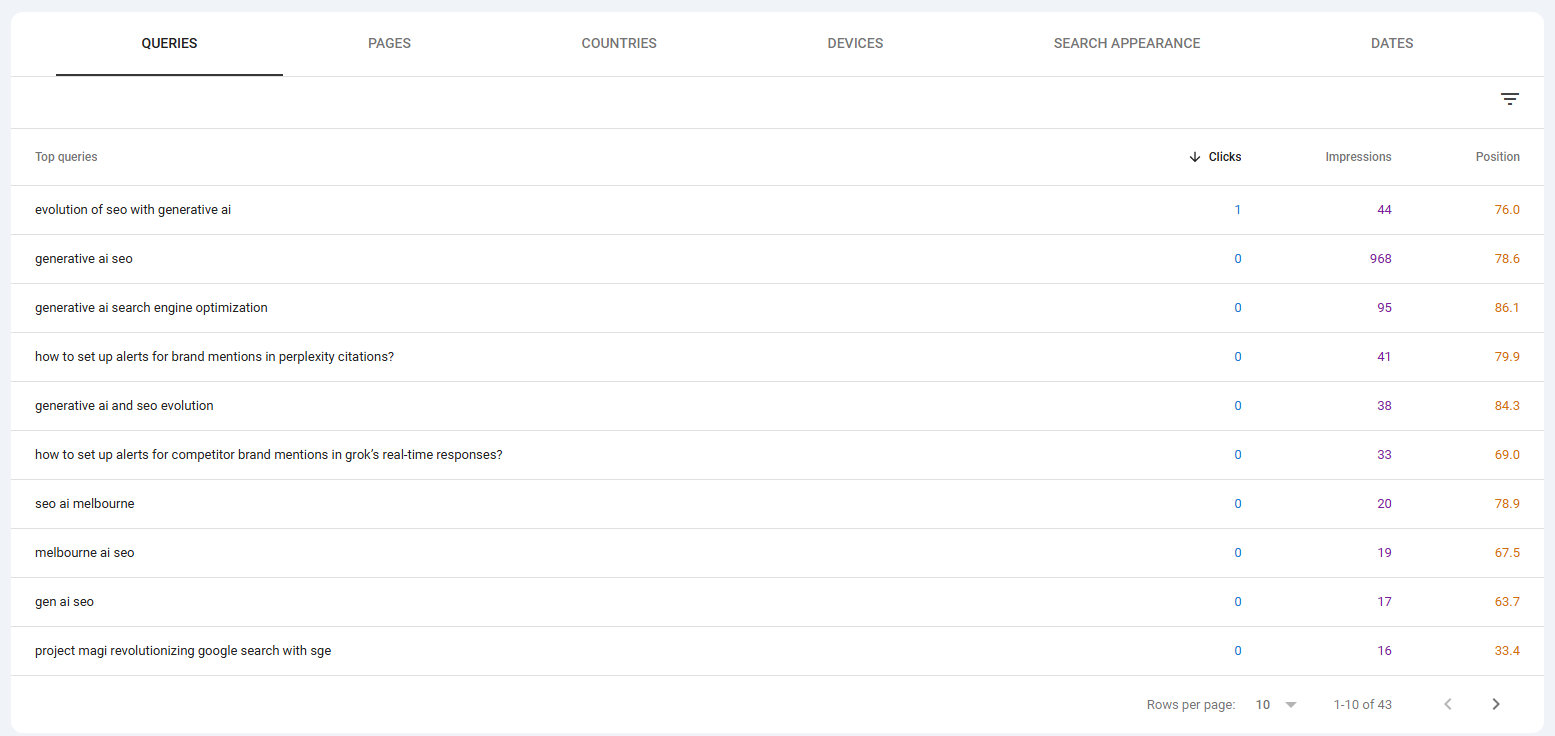
Data Insight
- Beyond Keywords: True authority is measured not by one ranking, but by the breadth of questions an AI trusts your content to answer.
- Spectrum of Intent: The query list indicates relevance across the full user journey – from broad strategic topics to forward-looking explorations like ‘evolution of seo with generative ai.’
- The Knowledge Corpus: This semantic spread is the definitive outcome of building a knowledge corpus, establishing the broad topical relevance required for deeper validation.
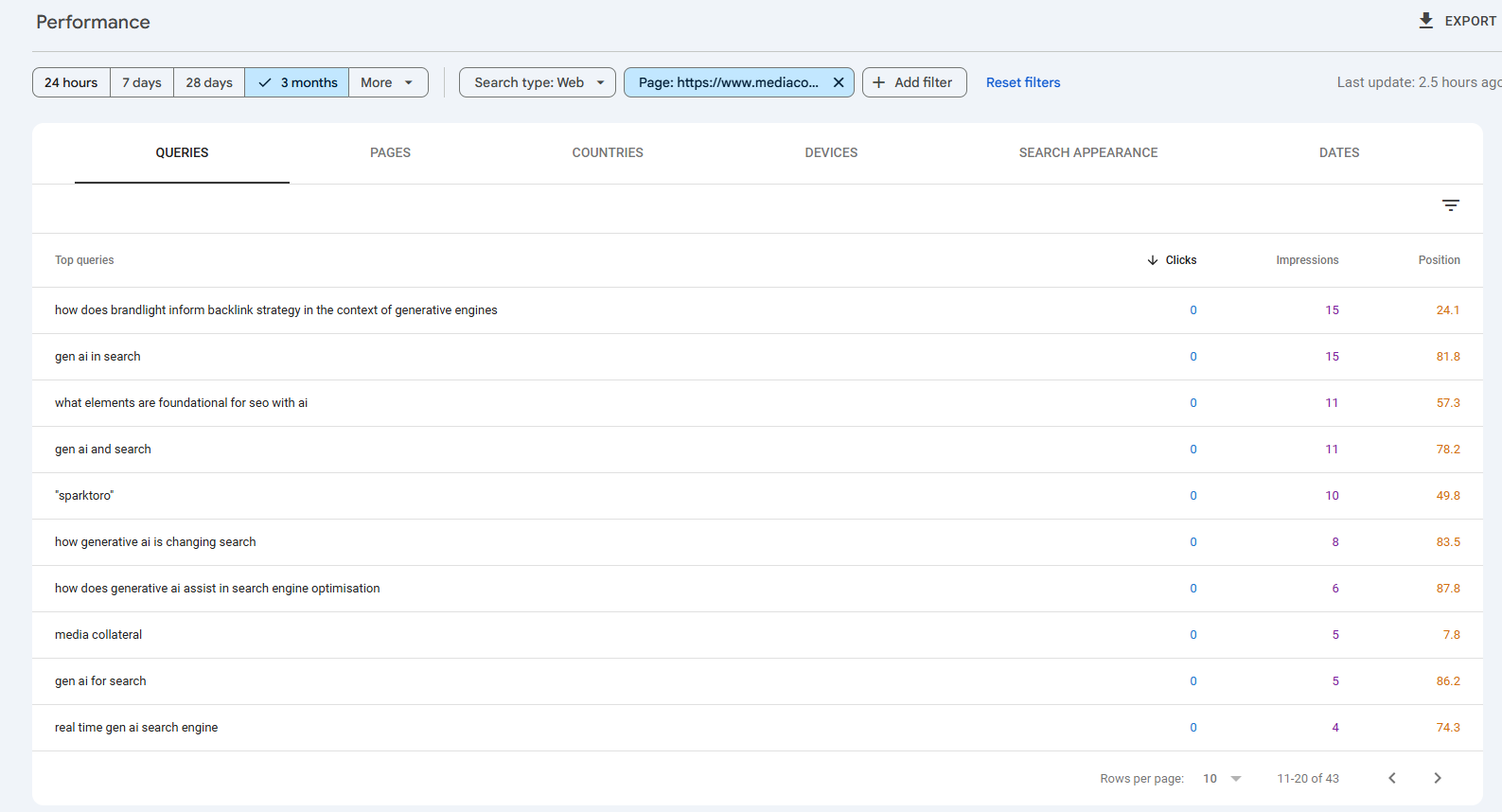
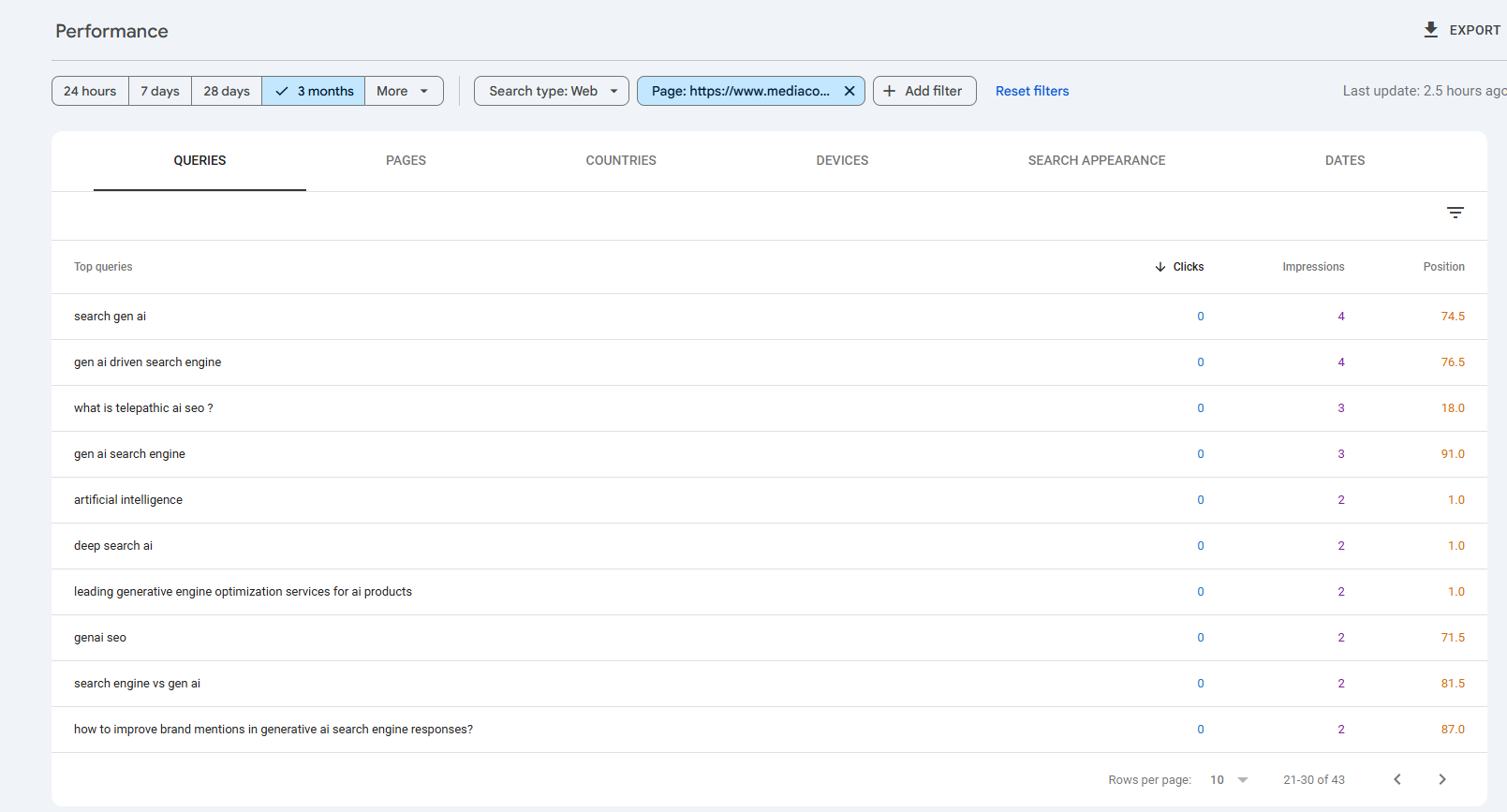
High-Intent Niches
Broad semantic coverage builds the foundation – but authority shows when that depth carries through to specific, high-intent queries in conversational search.
Google Search Console data indicates this is taking shape. The pillar page has reached the #1 position for several tightly focused terms, including:
- generative engine optimization
- generative search optimisation
- search engine optimization
Volumes are low – because discovery is fragmenting into long-tail, intent-driven queries. In that context, surfacing first for narrow, topic-aligned searches signals structural alignment with AI-led discovery, not underperformance.
These early placements suggest the page’s structure, depth, and specificity hold up as AI systems fan-out a topic across variants. As the knowledge corpus expands, this pattern compounds.
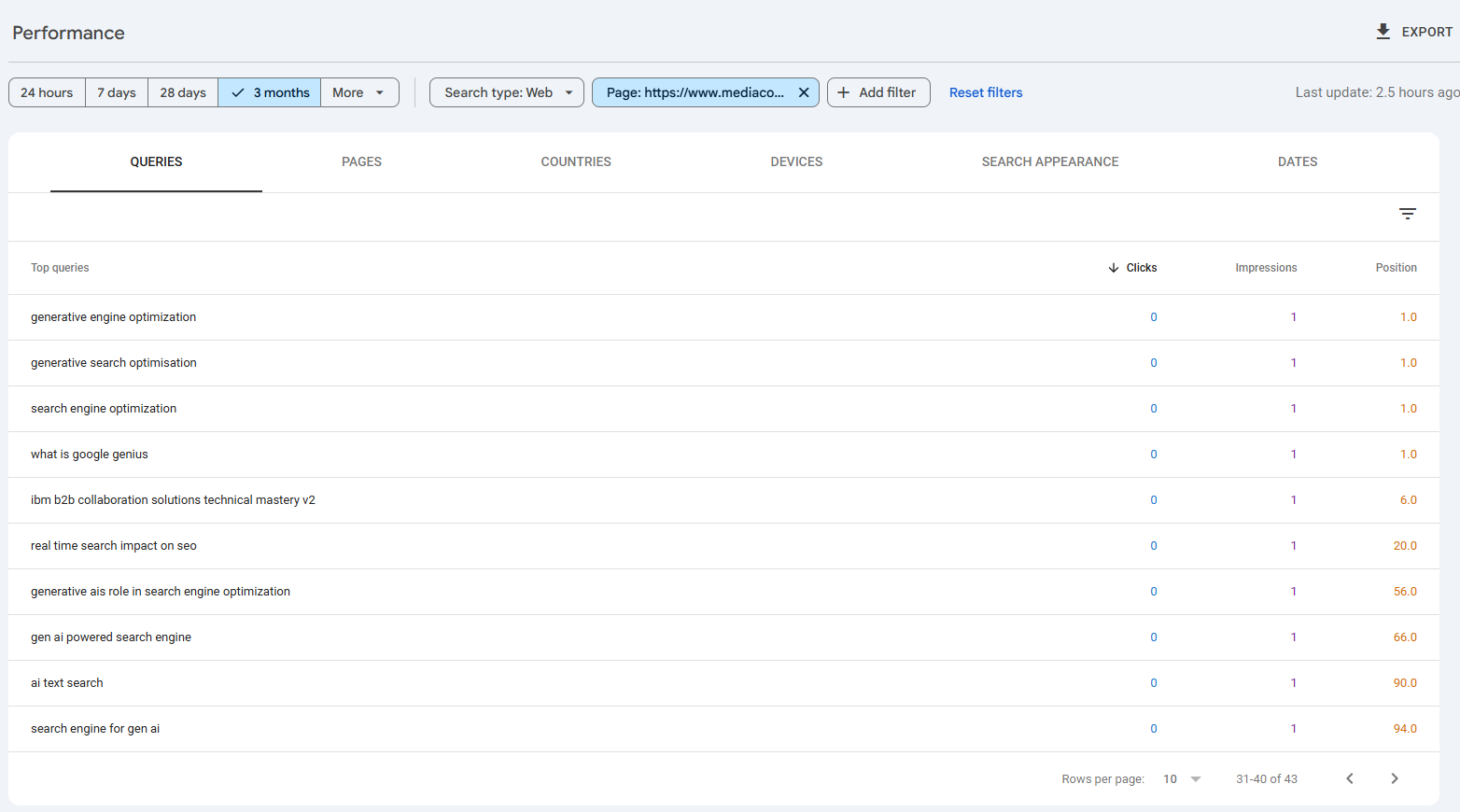

Data Insight
- Corpus effect: A semantically structured page can cover the field broadly – and surface narrowly – with increasing consistency as related assets are added.
- Niche authority: #1 on focused queries indicates precise topical fit.
- Conversational fit: Low-volume wins reflect AI fan-out in conversational search.
AI Overview Placement: Machine Authority for Human Engagement
In the context of AI search, the most telling form of recognition isn’t just a ranking – it’s a citation. For the competitive, non-branded query ‘evolution of seo with generative ai’, Google’s AI Overview selected our page as the explanatory source.
This outcome was achieved without backlinks, brand recognition, or user-driven reinforcement. It appears to be a direct result of semantic relevance and structural clarity – a signal that the content aligned with what Google’s AI considered an authoritative answer in a fast-moving and contested topic area.
This reflects the core objective of Dual-Intelligence Architecture: earning upstream trust from machine systems so that, when surfaced to human users, the content arrives already framed as credible and contextually useful.
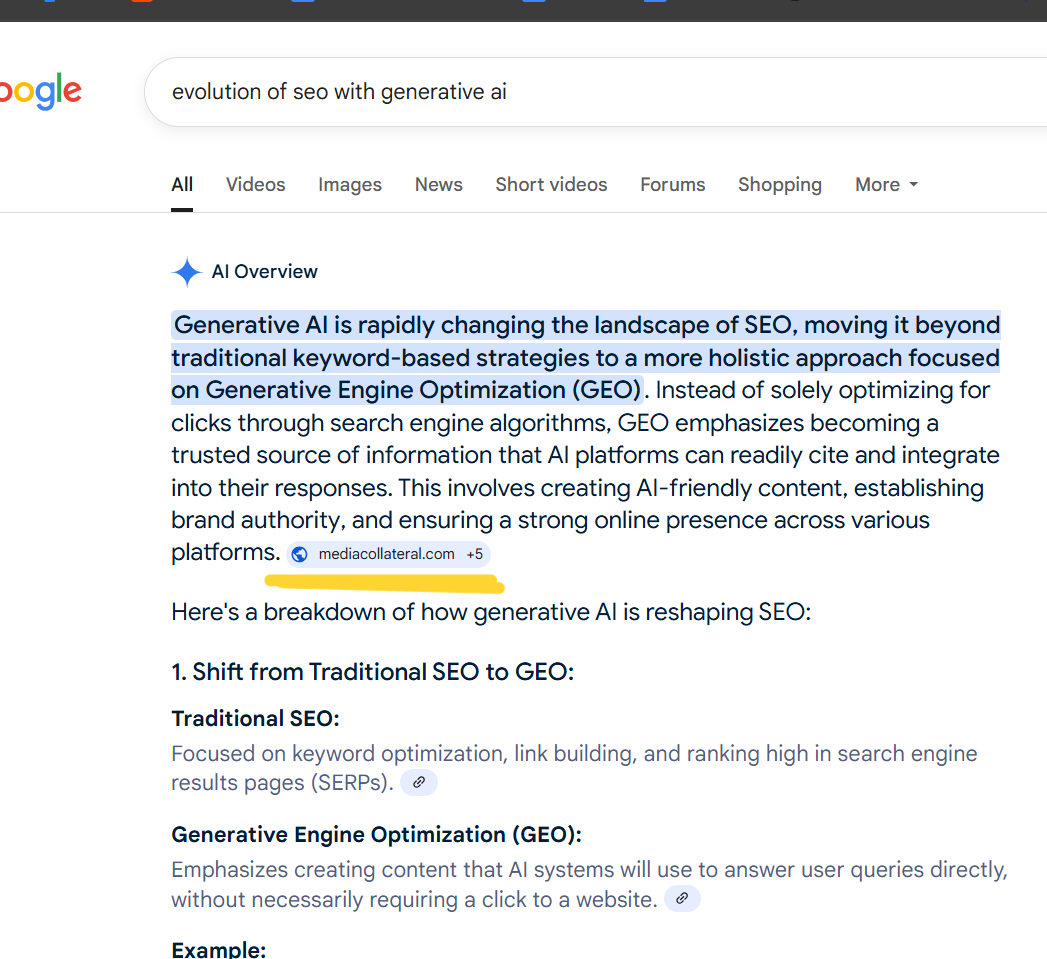
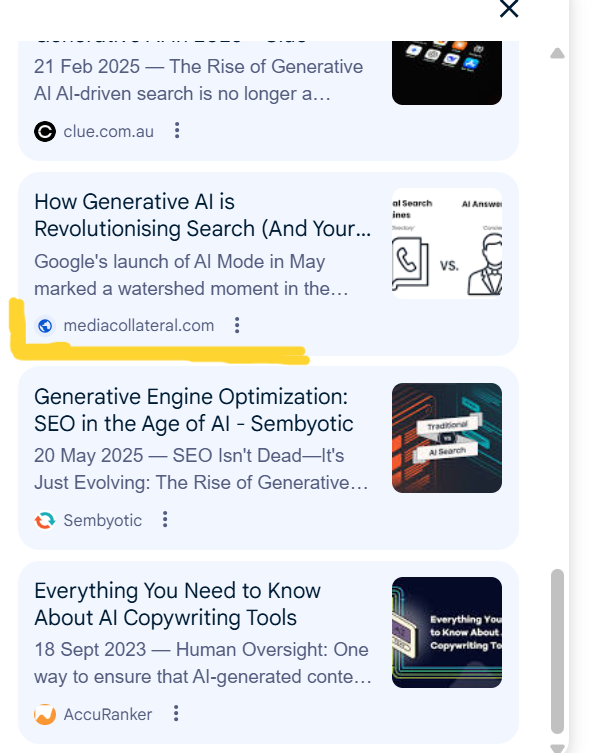
Captured in Google Incognito session on 27/6/2025
Data Insight
- Machine-Endorsed Recognition: A citation in an AI Overview reflects editorial selection by Google’s generative systems – a meaningful sign that the content is being interpreted as a high-quality, semantically aligned source.
- A New Kind of Visibility: This placement suggests the content is not just indexed but structured in a way that AI systems can readily interpret and prioritise – offering an early indicator of how machine comprehension is reshaping search visibility.
- Designed for Upstream Trust: This outcome reflects the underlying purpose of the DIA model – to build content that earns trust from machines first, enabling it to reach human users with contextual credibility already established.
Securing the Brand Narrative & conceptual ownership for your intellectual property (IP)
The second layer of authority is narrative clarity. For businesses, introducing a new concept, framework, product, or service in competitive markets, like Dual Intelligence Architecture (DIA) comes with an immediate challenge: when people search for your idea/IP, who controls the narrative?
Systems like Google’s AI Overviews/AI Mode, ChatGPT, and Perplexity need authoritative sources to cite and trust. Without clear definitional control, your intellectual property becomes vulnerable to:
- Misinterpretation by competitors
- Dilution by adjacent academic work/thought leadership
- Simple invisibility in AI-generated responses
You’re no longer just building valuable ideas – you’re competing for the right to define them in machine-mediated discovery.
We tested this principle with our own framework. Within 3 weeks of publication, Dual Intelligence Architecture achieved Google 1st Ranking and a Featured Snippet for its definitional query – appearing above academic content using similar terminology.
The second layer of authority is narrative clarity. After appearing in Google’s AI Overview for the broader query ‘evolution of seo with generative ai’, users looking to understand who we are – or what DIA refers to – are now met with a Featured Snippet that reflects our own definition.
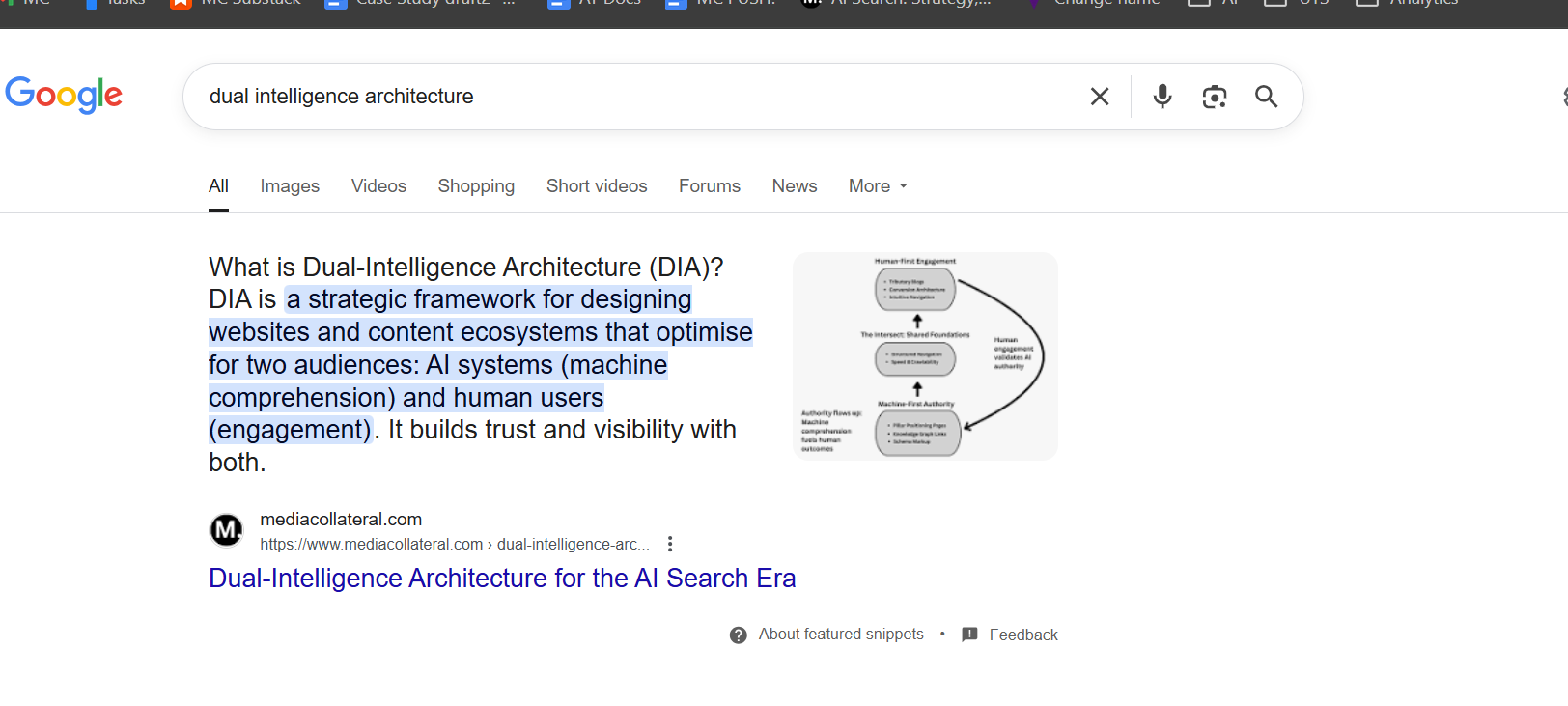
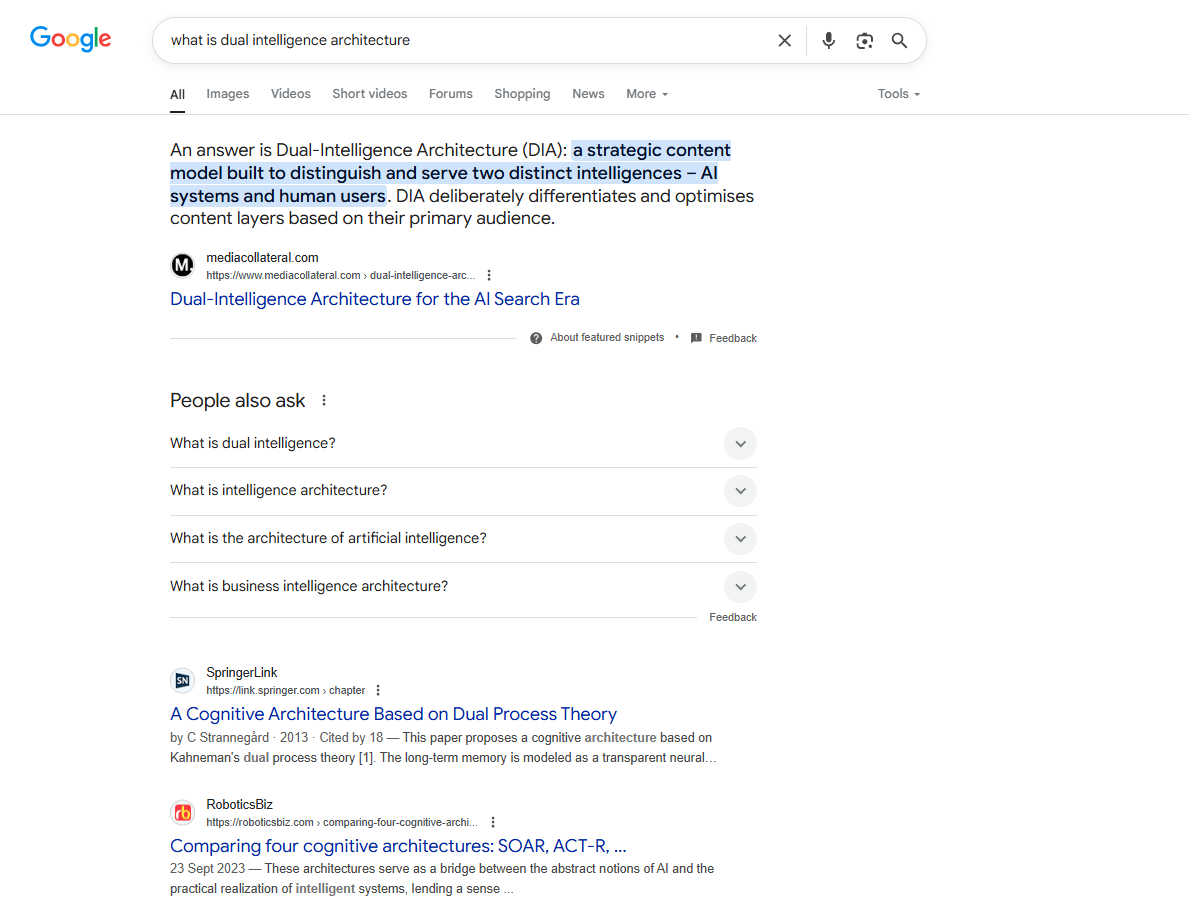
Captured in Google Incognito session on 27/6/2025
This outcome required deliberate content engineering:
- Structured definitions
- Supporting evidence and logical flow
- Machine-readable markup (schema)
- Semantic clarity for AI parsing
The content was built for AI comprehension first, with human readability as a secondary layer – a core principle of the DIA model.
Losing this definitional battle means your concept/IP becomes orphaned in the algorithmic landscape – findable perhaps, but not attributable to you as the originator.
This is where branded search emerges. Users aren’t browsing generically; they’re typing your organisation’s name or proprietary framework directly into the search bar.
That behaviour is a signal of:
- Recognition – the concept is now mentally tied to you
- Trust-seeking – they want confirmation from the source
- High intent – they’re actively moving toward deeper engagement, purchase consideration, or citation
Data Insight
- Semantic Definition Secured – at Speed: Within weeks of launch, Google surfaced our content as the Featured Snippet for a branded query – suggesting the content was structured clearly enough to be read, interpreted, and elevated without ambiguity.
- From Corpus to Conversion: This outcome reflects the intended flow of the DIA model – where upstream machine comprehension (via AI Overviews and semantic structure) supports downstream brand visibility and trust.
- Branded Queries as a Post-Click Conversion Path: In a zero-click environment, where users increasingly get answers without visiting a site, branded search has become a critical signal of interest and intent. Owning the response at that moment ensures the brand message lands clearly – even when no click occurs.
Branded Search and Agentic AI – New Conversion Pathways in AI Search
Across this study, we’ve shown how the Dual-Intelligence Architecture (DIA) content system builds authority through the search ecosystem:
- Upstream: Trust established with machines through semantic breadth, structured clarity, and original framing.
- Midstream: Recognition through AI Overviews and definitional snippets, where human users first encounter a brand framed as credible.
We now arrive at the final stage: Downstream, where this visibility must resolve into meaningful action. This post examines how conversion works in a landscape where the traditional rank → click → convert pathway has broken down.
In this seven-week test case, it is too early to demonstrate downstream results — but it is here that two emerging conversion pathways come into view: branded search and agentic AI. Both fit the online search economy’s evolving logic, channeling upstream trust into tangible business impact.
Pathway 1: Branded Search – The High-Intent Payoff
When a potential customer sees your brand cited in an AI Overview, ChatGPT or Perplexity during their discovery process, they gain recognition of your authority.
They may not click then, but the connection is made.
Days or weeks later, once they’ve done their research, they are ready to engage. They open a search bar and type a branded query – this could be the company name, but can also be a proprietary framework like Dual-Intelligence Architecture.
This is why having a machine read and surface your unique concepts is so critical; when a user sees an AI treat your framework as a credible answer, it builds foundational trust.
That subsequent, direct search is a fundamentally different type of action. This high-intent query can lead to several direct conversion paths:
- The user might see the website come up as the first link, click through, and fill out a contact form for an appointment.
- They may see the business in a Google knowledge panel and call or email directly from the search results page itself.
In either scenario, the link between the initial impression and the final conversion is broken, making the true ROI of that visibility impossible to measure with traditional analytics.
This is why it’s so important to step back and wean ourselves from the idea of a click being tied to an impression.
Zero-click visibility builds the trust that fuels these high-value, direct engagements later.
Pathway 2: Agentic AI – The Future Frontier
The second pathway is the new frontier, and its early stages are already visible in tools like Google’s AI Mode. This is the future of conversion: actions mediated entirely by AI.
Consider this possible scenario:
A marketing manager needs to hire an AI search specialist. They use AI for some initial research, exploring the topic and seeing which names are surfaced as credible sources.
A few days later, they delegate the task: “Find the best AI search specialist in my area and book an initial consultation for me.”
To execute this, the AI assesses multiple layers of information:
- Personal Context: It knows the manager’s role, company, and professional preferences.
- Search History: It references the manager’s recent research and what sources they engaged with.
- Provider Authority: It performs a broad analysis of potential providers, assessing their expertise, credibility, and authority on the domain.
The AI synthesises this and makes a choice. The manager simply gets a notification:
“I’ve booked you a consultation for Thursday in the free spot in your diary with Media Collateral. You’ll be speaking with their lead strategist to discuss your needs.”
In this future, brands that build content that clearly explains and differentiates their unique expertise – in a way the AI understands and trusts – are the ones that will be well-placed to be put forward.
This is the ultimate conversion: being chosen by an AI acting on behalf of a high-intent buyer.
Upstream Trust, Downstream Clarity
The Dual-Intelligence Architecture model is built on a simple premise: that in an AI-mediated environment, content must earn trust from machines before it ever reaches a human audience.
What we’ve outlined here isn’t a finished system – but an early demonstration of how structured clarity, semantic breadth, and source-level precision can start to build that trust.
The real test isn’t just what gets clicked – it’s what gets surfaced, cited, and carried forward through the network of machine decisions that increasingly shape discovery.
As search continues to fragment and AI takes on a more active role in guiding choices, content that’s designed to be understood – both structurally and strategically – will compound in value.
This is how upstream machine authority becomes downstream human clarity. And it’s where discoverability begins to shift – from being found, to being chosen.
6. FAQs: Generative Engine Optimisation (GEO)
1. What is Generative Engine Optimisation (GEO), and how is it different from traditional SEO?
GEO is a strategic response to the rise of AI-powered search engines. Unlike traditional SEO, which focused on ranking for keywords and earning clicks, GEO is about building structured, authoritative content that AI systems can parse, cite, and trust. It shifts the emphasis from click-through rates to upstream visibility, citation, and semantic trust.
2. How is generative AI changing the way search engines work?
Search engines now use generative AI to produce direct answers, not just return links. These systems rely on trusted sources—structured, semantically rich content that can be referenced in real time. Visibility now depends on whether your content is understood and trusted by machines.
3. What is Dual-Intelligence Architecture (DIA), and why does it matter?
DIA is our strategic framework for building content that serves both AI systems and human users. It prioritises upstream machine authority (to earn trust and citation from AI engines) and downstream human engagement (to drive awareness and conversions through indirect pathways). It’s designed for the realities of the AI search era.
4. Why is my content getting high impressions but low clicks?
This is a feature, not a flaw. In today’s AI-driven environment, your content might be surfaced in AI-generated answers, cited in overviews, or inform agent-based interactions—all without a click. High impressions signal machine trust. Downstream impact—like branded searches or agentic fulfilment—often happens off-path.
5. What does it mean to build a machine-readable knowledge corpus?
It means structuring your content so that AI systems can interpret and index it accurately. That includes clear entity relationships, schema markup, internal linking, and semantically coherent content. Think of it as building a library for machines—one they can quote, reference, and rely on.
6. Why does DIA focus so heavily on niche dominance?
AI systems value confidence over breadth. They cite sources that answer questions with clarity and specificity. By focusing on niche, intent-rich queries, you become the best answer in your category—especially in trust-sensitive areas like finance, health, and professional services.
7. What kind of content ranks well in AI-driven search?
Content that is semantically rich, structurally coherent, and topically deep. It needs to align with diverse user intents, reinforce key entities, and be machine-parsable. Authority is built not through volume, but through trust, clarity, and citation-readiness.
8. How can I prepare my content for future AI agents that take action on behalf of users?
Start now by structuring content that AI systems can trust. That means aligning with commercial queries, using structured data, and creating service-oriented pages with clear fulfilment logic. Today’s semantic visibility sets the foundation for tomorrow’s agentic execution.
9. How do I measure success if clicks are no longer the main metric?
Success is now about your brand’s presence and influence within AI-generated answers, citations in AI Overviews and featured snippets, growth in branded search and direct navigation, and recognition across a spectrum of entity-rich queries. Google Search Console milestone alerts and off-path conversions are increasingly important indicators of digital authority.